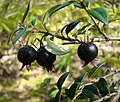Classification System: APG IV
Superregnum: Eukaryota
Regnum: Plantae
Cladus: Angiosperms
Cladus: Eudicots
Cladus: Core eudicots
Cladus: Rosids
Cladus: Eurosids II
Ordo: Myrtales
Familia: Myrtaceae
Subfamilia: Myrtoideae
Tribus: Myrteae
Subtribus: Ugninae
Genus: Ugni
Species (4 accepted): U. candollei – U. molinae – U. myricoides – U. selkirkii
Source(s) of checklist:
The Plant List
Name
Ugni Turcz. Bull. Soc. Imp. Naturalistes Moscou 21(I): 579 (1848)
References
Primary references
Turczaninow, N.S. 1848. Decades Quarta et Quinta Generum Adhuc non Descriptorum. Bulletin de la Société Imperiale des Naturalistes de Moscou 21(I): 570-591. BHL Reference page.
Links
Hassler, M. 2020. Ugni. World Plants: Synonymic Checklists of the Vascular Plants of the World In: Roskovh, Y., Abucay, L., Orrell, T., Nicolson, D., Bailly, N., Kirk, P., Bourgoin, T., DeWalt, R.E., Decock, W., De Wever, A., Nieukerken, E. van, Zarucchi, J. & Penev, L., eds. 2020. Species 2000 & ITIS Catalogue of Life. Published online. Accessed: 2020 Oct. 10. Reference page.
International Plant Names Index. 2020. Ugni. Published online. Accessed: October 10 2020.
Govaerts, R. et al. 2020. Ugni in Kew Science Plants of the World online. The Board of Trustees of the Royal Botanic Gardens, Kew. Published online. Accessed: 2020 October 10. Reference page.
Tropicos.org 2020. Ugni. Missouri Botanical Garden. Published online. Accessed: 10 October 2020.
Ugni is a genus of plants in the myrtle family Myrtaceae, described as a genus in 1848.[1][2] It is native to western Latin America from the Valdivian temperate rain forests of southern Chile (including the Juan Fernández Islands) and adjacent regions of southern Argentina, north to southern Mexico.[3]
They are shrubs with evergreen foliage, reaching 1–5 m tall. The leaves are opposite, oval, 1–4 cm long and 0.2-2.5 cm broad, entire, glossy dark green, with a spicy scent if crushed. The flowers are drooping, 1–2 cm diameter with four or five white or pale pink petals and numerous short stamens; the fruit is a small red or purple berry 1 cm diameter.[4][5][6]
Species
| Image | Scientific name | Distribution |
|---|---|---|
 |
Ugni candollei (Barnéoud) O.Berg | Central to southern Chile |
 |
Ugni molinae Turcz. | Central to southern Chile, southern Argentina; naturalized in New Zealand and Juan Fernández Islands |
 |
Ugni myricoides (Kunth) O.Berg | Mexico (Hidalgo, Veracruz, Puebla, Oaxaca, Chiapas), Central America, South America (Guyana, Venezuela, Guyana, Colombia, Ecuador, Peru, NW Brazil (Amazonas + Roraima)). |
| Ugni selkirkii (Hook. & Arn.) O.Berg | Robinson Crusoe Island |
Etymology
The scientific name derives from the Mapuche Native American name Uñi for U. molinae. The genus was formerly often included in either Myrtus or Eugenia; it is distinguished from these by the drooping flowers with stamens shorter than the petals.
Uses
Ugni molinae (syn. Myrtus ugni, Eugenia ugni) is grown as an ornamental plant for its edible berries. Some commercial "strawberry flavouring" is made from this species, not from strawberries. Myrtus ugni fruits are oblate and up to 1.5 cm in diameter with a purplish to deep cranberry color. They are used to make piquant drinks, desserts, jams, and jellies.[7]
References
Turczaninow, Nicolai Stepanowitsch. 1848. Bulletin de la Société Impériale des Naturalistes de Moscou 21(1): 579 in Latin
Tropicos, Ugni Turcz
Kew World Checklist of Selected Plant Families
Davidse, G., M. Sousa Sánchez, S. Knapp & F. Chiang Cabrera. 2009. Cucurbitaceae a Polemoniaceae. 4(1): i–xvi, 1–855. In G. Davidse, M. Sousa Sánchez, S. Knapp & F. Chiang Cabrera (eds.) Flora Mesoamericana. Universidad Nacional Autónoma de México, México.
Sánchez-Vindas, P. E. 2001. Calycolpus, Eugenia, Myrcia, Myrcianthes, Myrciaria, Pimenta, Plinia, Psidium, Syzygium, Ugni. En: Stevens, W.D., C. Ulloa, A. Pool & O.M. Montiel (eds.), Flora de Nicaragua. Monographs in systematic botany from the Missouri Botanical Garden 85(2): 1566, 1570–1574, 1575–1580
Landrum, L. R. & M. L. Kawasaki. 1997. The genera of Myrtaceae in Brazil: an illustrated synoptic treatment and identification keys. Brittonia 49(4): 508–536
National Academies Press, Lost Crops of the Incas
Retrieved from "http://en.wikipedia.org/"
All text is available under the terms of the GNU Free Documentation License

